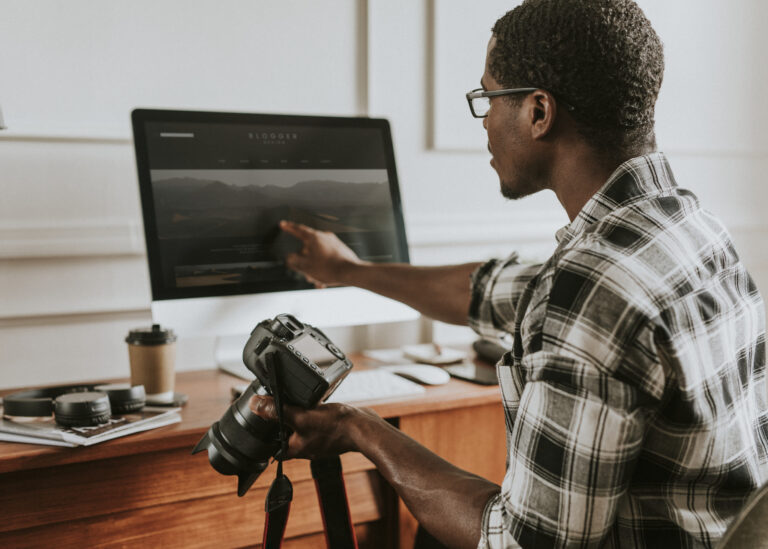Hi guys, I’m Michele Perry with Designed to Thrive Creative. I’m a business strategist, and educator for creatives and entrepreneurs just like you and I’m also an expert in creativity resilience and crisis leadership. Basically, that means I help creatives to nurture their creativity, nail their strategy, and truly build brands that thrive from the inside out, even in the middle of seasons of crisis.
So as I’m sure we’re all aware, we’re in the middle of some history-making times of global crisis with the COVID-19 pandemic. I’m going to apologize in advance for my voice and my cough if it crops up. I’m on some really good cough meds right now, but it still might show up. I actually am recording this on full-quarantine waiting for my results to come back with double pneumonia.
So I’m really glad that technology lets me continue to have this conversation with you guys. And I spent seven years in an active conflict zone in Central Africa. I went in when the nation of what is now South Sudan was still Sudan and began to build relationships and partnerships with local leaders in the province in which I entered and set up. And worked with them to help identify and rescue vulnerable kids that were vulnerable to exploitation or trafficking and we tried to do family reunification. And if that didn’t work, they came and lived with us.
So yeah, it was how to manage, like, an active conflict-zone dynamic, living with a hundred and thirty kids with no running water, no electricity other than a battery, no paved roads, no civil policing, very limited telecommunication capability, no banking. It was literally the bush bush and there we dealt with things like cholera and typhoid outbreaks. We had ebola outbreaks 30 to 40 miles down the road from us.
Fortunately, it never came into the-the town that we were in but lots of opportunity to learn about what kind of mindsets and leadership works in times of really acute, as well as prolonged, crisis. So I wanted to hop on here and share with you some of my favorite lessons.
Well, you may have heard it said that a picture is worth a thousand words. I have to think that these pictures are worth a few million. Of course, I’m terribly biased and I am so grateful and privileged that I got to call South Sudan home for 7 years and live and work alongside some of the most beautiful, courageous, strong, generous people that I have ever met and I will be forever humbled by that. And, so, all of that gave me ample opportunity to learn and to really embrace walking into some strategic mindsets to consider in times of crisis. This is our dream primary school, and all these are some of the kids that we were just – we were just so privileged to be able to provide an education for.
So with the first of these strategic mindsets, we’re going to be looking at a number of different things and I’m going to go quickly, but you will be able to download a workbook that goes with as well, as I will make these slides available.
1. Focus
So, the first of the strategic mindsets to consider is Focus. And one of the first things I learned really quickly is what I focused on expanded. So if I focused on the negativity, and I focused on fear, and I focused on lack and “oh my gosh, I’m so small,” I would paralyze myself to not wanting to leave my mud hut, so I learned to focus on the things that I could control and there was always no matter how bad the situation one thing I could control, and that was me. That was my response. I also learned that feeling fear and panic is normal but being overwhelmed by them in the middle of a crisis really isn’t all that helpful.
2. Filter
Filter–so you, and power what you focus on and what feeds that focus is all of the input coming in, right? So I have learned that you have to be really, really strategic and what you filter what information that you choose to listen to and not all information sources in a crisis have equal merit, equal weight, or equal credibility.
So we need to be really selective about our media consumption and the messages that we internalize, because the messages we internalize becomes the self talk that we tell ourselves, and then that becomes perpetuated into our actions, right? So social media is a wonderful tool if we’re using it to build broader community. But again, we’ve got to be aware of what messages are we embracing because they could be hindering instead of helping us.
3. Family
Another critical mindset was Family.
When our kids came to live with us, we didn’t welcome them into an orphanage, we welcomed them into a home and into a really big family that loved and cared for them. And when we were making choices with our staff and our leaders, you know, we found that we really had to consider the needs of the most vulnerable among us first – that we had a community responsibility to look after those that were as least able to protect themselves and community is how we survived even unimaginable crises.
4. Future-Facing
Also, another really important mindset to keep in mind is to be future-facing in our outlook. So instead of being focused on the past, it’s facing into the future and even if it’s really, really, really, really small, do the next thing. One of the biggest things that I learned was when I was overwhelmed, I would sit down, I would make a list and I would list things that I would normally not even normally list, like really small steps of some things that, because then I would check them off and then I would feel like something was getting done, and it really helped my mindset of not feeling so powerless in terms of the face of everything that, you know, that we were dealing with that day or that season.
And we talked a lot with our leaders about planning three layers deep. We looked at the short-term, which we looked was the basically current time frame to two weeks out, near-term, four to eight weeks, and mid-term, two to 12 months, and when we were in the middle of major crises that wasn’t the time that we broke out our dream hats and started like long-term planning on everything that we dreamt and wanted to see happen in our in our area.
5. Avoid What-Ifs
I learned early on – do not play the “what if” game. Don’t do it! What if this, well what if that happens, and what if this happens and yeah, there is a creative problem-solving place for that but this isn’t it. Crisis is not the place to start going ”what if” because it can really become overwhelming and self-defeating.
So we need to focus on facts, focus on what is, and make plans and walk accordingly and stay grounded with what is and keep adjusting the plan as needed.
And then, in facing the future, leaning into radical generosity not just as a – as a position in the place of crisis, but as an actual brand, foundational statement of who your business is. You know how we communicate in crisis it either builds up or breaks down the trust – that’s going to be crucial to our credibility and our ability to bounce back after the crisis passes.
So let’s break this down and talk, just a little bit, about, “How can we build trust by the way that we communicate as leaders and entrepreneurs in the middle of crisis?” These are some mindsets and some techniques and thoughts about that.
Again, supporting our local community, making sure we’re stewarding our own story well so that we’re adding certainty, and we’re adding credibility, we’re embracing creativity as a problem-solving tool, really making sure that we stay on top of our updates and we let all of the stakeholders, including our clients, know changes – that we look for ways to pivot, and to take skills and apply them in new ways, that we share with all of our stakeholders, our staff, our co-leaders, our clients, and customers the “why” behind the “what.” Why are we making the changes that we’re doing, and that we use the slow down instead of thinking, “oh, this is time off,” or really dwelling on kind of the things that we can’t change?
We can use the slow down to strengthen our systems and to make a stronger foundation for us moving forward after the crisis passes. So, again, choosing abundance over scarcity, we dealt with crazy shortages.
6. Four S’s To Strengthen Our Systems
So here are four things that I would tell all of our visitors that would come when we were in the middle of a shortage.
The first thing–stretch.
How can I stretch what I have so as a business? How can we stretch the resources and things that we, the assets that we already have? How can we reduce, reuse, and repurpose?
Substitute–what can I DIY? Research alternate ways to do things.
Simplify–do you really, really, really need it, or can you simplify and do without it and cut that expense?
And share–how can we take what we have and really use it to care for our communities and for others that are actually hurting more than we are.
So if you enjoyed this, I created kind of a little, mini PDF guide on strategic mindsets in times of crisis, coaching questions that are going to help you apply these mindsets, and a guide to developing preparedness in your business using the storm that we are all in right in the middle of to actually help you prepare your business to be stronger for storms that will come after this one passes by.
And if you do download it, please share, screenshot your pages, tag me on Instagram, hang out with me there. I’m @dmicheleperry and come over and say hi at designedtothrivecreative.com. That’s where I live on the internet. And it’s been awesome to be with you guys.
Be well, stay safe, and thanks so much for letting me share this time with you.



